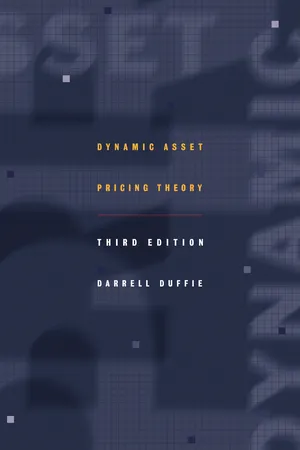
- 488 pages
- English
- PDF
- Available on iOS & Android
About this book
This is a thoroughly updated edition of Dynamic Asset Pricing Theory, the standard text for doctoral students and researchers on the theory of asset pricing and portfolio selection in multiperiod settings under uncertainty. The asset pricing results are based on the three increasingly restrictive assumptions: absence of arbitrage, single-agent optimality, and equilibrium. These results are unified with two key concepts, state prices and martingales. Technicalities are given relatively little emphasis, so as to draw connections between these concepts and to make plain the similarities between discrete and continuous-time models.
Readers will be particularly intrigued by this latest edition's most significant new feature: a chapter on corporate securities that offers alternative approaches to the valuation of corporate debt. Also, while much of the continuous-time portion of the theory is based on Brownian motion, this third edition introduces jumps--for example, those associated with Poisson arrivals--in order to accommodate surprise events such as bond defaults. Applications include term-structure models, derivative valuation, and hedging methods. Numerical methods covered include Monte Carlo simulation and finite-difference solutions for partial differential equations. Each chapter provides extensive problem exercises and notes to the literature. A system of appendixes reviews the necessary mathematical concepts. And references have been updated throughout. With this new edition, Dynamic Asset Pricing Theory remains at the head of the field.
Frequently asked questions
- Essential is ideal for learners and professionals who enjoy exploring a wide range of subjects. Access the Essential Library with 800,000+ trusted titles and best-sellers across business, personal growth, and the humanities. Includes unlimited reading time and Standard Read Aloud voice.
- Complete: Perfect for advanced learners and researchers needing full, unrestricted access. Unlock 1.4M+ books across hundreds of subjects, including academic and specialized titles. The Complete Plan also includes advanced features like Premium Read Aloud and Research Assistant.
Please note we cannot support devices running on iOS 13 and Android 7 or earlier. Learn more about using the app.
Information
Table of contents
- Cover
- Title
- Copyright
- Contents
- Preface
- PART I: DISCRETE-TIME MODELS
- PART II: CONTINUOUS-TIME MODELS
- APPENDIXES
- Bibliography
- Symbol Glossary
- Author Index
- Subject Index